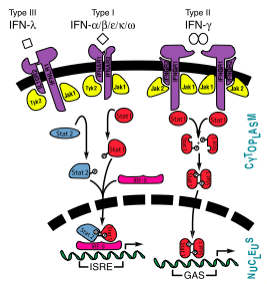Interferons were the first cytokines discovered and were identified by Isaacs and Lindenmann. These proteins were classified as interferons because they interfered with virus growth.[1] The initial experiments performed poorly characterized the interferons, and was based merely on bioactivity. Advances in scientific instrumentation and technique have allowed for greater understanding and visualization of not only the structure but also the mechanisms of the various types of inteferons.[2] The interferons were originally classified as leukocyte (interferon-α), fibroblast (interferon-β), and immmune (interferon-γ), although today they are classified into types I (α, β, ε, κ, ω), II (γ), and III (λ).[1][2]
Type I
Type I interferons are homologous helical cytokines that effect a wide variety of cells pleiotropically. These effects range from antiviral activity to antibacterial, antiprozoal, immunodulatory, and cell growth regulatory functions. Without Type I interferons, the survival of the higher vertebrates would be impossible. Because of their strong antiviral and antiproliferative effects, these interferons are used in the treatment of numerous cancers, hepatitis C, and multiple sclerosis.
All type I interferons bind to a cell surface receptor consisting of two subunits: IFNAR1 and IFNAR2. These receptors belong to a class II helical cytokine receptor family (HCRII). Other members of this family include the interferon-γ receptor (IFNGR), tissue factor (TF), the interleukin 10 receptor (IL20R1 and IL20R2), IL-28BP, IFNLR, and IL28Rα.[3]. For additional details see IFNAR.
Interferon-α
Interferon alpha has many with two : one between the , and the other between . It has seven and has several The helices A, C, and F run to one another, and to B, E, and G which run to each other.
does not run parallel or anti-parallel to either set, but rather runs at a 45-90 degree angle to them. Helix A consists of residues 10-12; Helix B of 40-43; Helix C of 53-68; Helix D of 70-75; Helix E of 78-100; Helix F of 109-132; and Helix G of 137-158.
Interferon-β
A protein growth factor that stimulates an antiviral defense is one of the only two known vertebrate structural genes that lacks introns.[4] Interferon-β has a 31% sequence homology to interferon-α . It is a relatively simple biological response modifier, with several . It consists of five , as compared to the seven of interferon-α, as well as multiple interconnecting . Helices A, B and D run , and helices C and E run to the other three helices, but to one another. Helix A consists of residues 6-23; Helix B consists of residues 49-65; Helix C consists of residues 77-91; Helix D consists of residues 112-131; and Helix E consists of residues 135-155.[5][6].
Interferon-β is used as a treatment for Multiple sclerosis, an autoimmune disease defined by Nylander and Hafler as "a multifocal demyelinating disease with progressive neurodegeneration caused by an autoimmune response to self-antigens in a genetically susceptible individual."[7] Inflammation is the primary cause of damage in MS, and though the effects of the disease are well known and various treatments exist for the disease, the exact identity of an antigen or infectious agent that causes the initiation of a myriad of symptoms is unknown.[8]. For more details see User:Chengfeng Ren/IFN beta 1a.
Comparison of three interferons

Interferon JAK-STAT Pathway showing interferons types I, II, and III
[1] Signaling and Receptor Interactions
The signaling pathways of interferons are interesting as type I interferons share the same receptors IFNAR1 and IFNAR2. Type II interferon-γ has receptors IFNGR1 and IFNGR2, but needs two interferon-γ to signal, as illustrated in the image to the right. Interestingly enough, types I and III act together in the JAK-STAT pathway, while type II acts alone. Interferon-α and -β bind to the same receptors as one another, the affinities with which they bind to IFNAR1 and IFNAR2 differ. While the binding to IFNAR2 is stronger for both in comparison to IFNAR1, interferon-β has a much stronger affinity for IFNAR1 than interferon-α.[9]
Interferon-α to an interferon receptor mainly with helices C and G. There are many within 4 angstroms of one another. These residues could form many , illustrated in white dotted lines. Given that interferon-α does not undergo many structural changes upon binding to interferon receptor II, Quadt-Akabayov et al. have concluded that the binding mechanism is similar to that of a lock and key. Interferons -α and -β interact with a receptor at the cell surface.[10] This receptor has : an
, with two disulfide bonds, a , with one disulfide bond, and a . The of the receptor have no secondary structure, allowing for some serious flexibility, leading to .[11]

